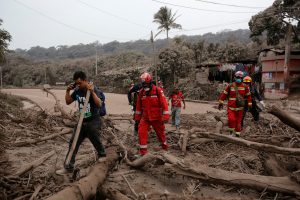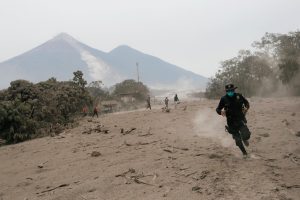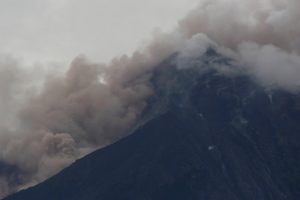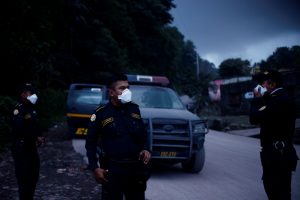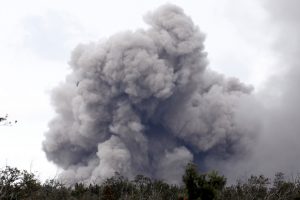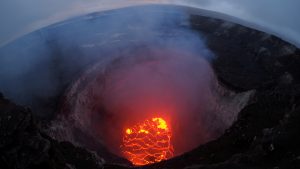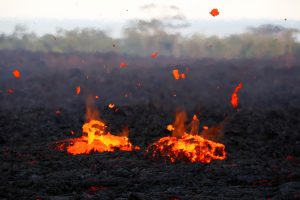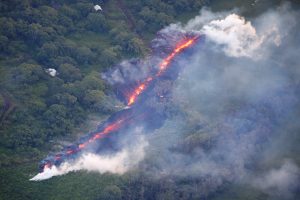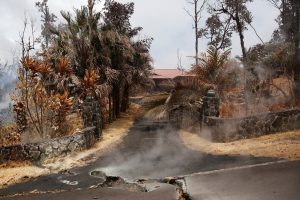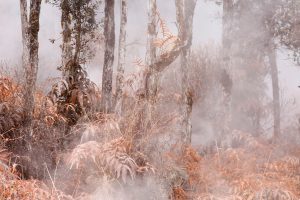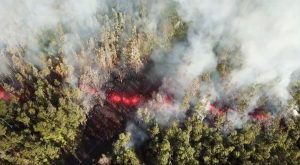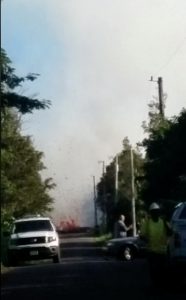
By Terray Sylvester
PAHOA, Hawaii (Reuters) – Hawaii faced a new hazard on Sunday as lava flows from Kilauea’s volcanic eruption could produce clouds of acid fumes, steam and glass-like particles as they reach the Pacific, authorities said.
Civil defense notices cautioned motorists, boaters and beachgoers to beware of caustic plumes of “laze” formed from two streams of hot lava pouring into the sea after cutting across Highway 137 on the south coast of Hawaii’s Big Island late on Saturday and early Sunday.
The bulletins also warned that reports of toxic sulfur dioxide gas being vented from various points around the volcano had tripled, urging residents to “take action necessary to limit further exposure.”
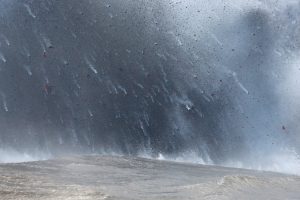
Lava flows into the Pacific Ocean southeast of Pahoa during ongoing eruptions of the Kilauea Volcano in Hawaii, U.S., May 20, 2018. REUTERS/Terray Sylvester
Laze – a term combining the words “lava” and haze” – is a mix of hydrochloric acid fumes, steam and fine volcanic glass specks created when erupting lava, which can reach 2,000 degrees Fahrenheit (1,093 degrees Celsius), reacts with sea water, Hawaii County Civil Defense said in a statement.
“Be aware of the laze hazard and stay away from any ocean plume,” the agency said, warning that potential hazards include lung damage, as well as eye and skin irritation.
Under Sunday’s conditions, with strong winds and copious amounts of lava hitting the ocean, the laze plumes could extend as far as 15 miles (24 km), mostly along the coast and offshore, though the hazard would diminish the farther out to sea it blows, according to USGS geologist Janet Babb.
Authorities cautioned, however, that wind patterns can change abruptly. The U.S. Coast Guard was “actively monitoring” the area to keep away all vessel traffic except permitted tour boats, the civil defense office said.
Laze killed two people when a lava flow reached the coast in 2000, and even a wisp can cause eye and respiratory irritation, the U.S. Geological Survey said. Acid rain from laze has corrosive properties equivalent to diluted battery acid, the agency said.
The section of coastal Highway 137 and a nearby a state park in the area where lava was pouring into the ocean were both closed, and another road in the vicinity was restricted to local traffic as a precaution due to elevated levels of sulfur dioxide gas.
An air quality index for Kona, about 40 miles (64 km) northwest of the eruption site, was at “orange” level, meaning that older individuals and those with lung problems could be affected.
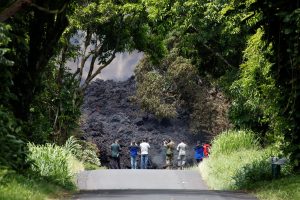
Journalists and Hawaii National Guard soldiers document a lava flow on Highway 137 southeast of Pahoa during ongoing eruptions of the Kilauea Volcano in Hawaii, U.S., May 20, 2018. REUTERS/Terray Sylvester
EARTHQUAKES, ASH ERUPTIONS
Kilauea, one of the world’s most active volcanoes, began extruding red-hot lava and sulfuric acid fumes through newly opened fissures on the ground along its eastern flank on May 3, marking the latest phase of an eruption cycle that has continued nearly nonstop for 35 years.
The occurrence of new lava-spewing vents, now numbering at least 22, have been accompanied by flurries of earthquakes and periodic eruptions of ash, volcanic rock and toxic gases from the volcano’s summit crater.
The lava flows have destroyed dozens of homes and other buildings, ignited brush fires and displaced thousands of residents who were either ordered evacuated or fled voluntarily.
The volcano has also fed a phenomenon called vog, a hazy mix of sulfur dioxide, aerosols, moisture and dust, with fine particles that can travel deep into lungs, the USGS said.
On Saturday, authorities reported the first known serious injury from the eruptions – a homeowner whose leg was shattered by a hot, solid lumb of lava called a “lava bomb” while standing on the third-floor balcony of his home.
Mark Clawson, a friend of the victim who did not want his name used, lives near where his friend was staying as caretaker, and heard screaming and saw the harrowing aftermath, he told Reuters.
Apparently a fiery 5-pound “lava bomb” about the size of a dinner plate was launched from a fissure about 200 yards from the house, Clawson said.
“Most of them (lava bombs) arc high in the air, but every now and again there’s one that gets shot like a rifle, more horizontal and that’s what happened here,” he said.
It also started a small fire, which Clawson helped douse.
He said doctors had to pick sharp, hardened fragments of lava out of the wound, but the prognosis is good for his friend.
With Highway 137 severed, authorities were trying on Sunday to open up nearby Highway 11, which was blocked by almost a mile of lava in 2014, to serve as an alternate escape route.
The Hawaii National Guard has warned of additional mandatory evacuations if more roads become blocked.
Officials at the Hawaii Volcano Authority have said hotter and more viscous lava could be on the way, with fountains spurting as high as 600 feet (182 meters), as seen in a 1955 eruption.
(Additional reporting by Jolyn Rosa in HONOLULU, Ian Simpson in WASHINGTON, and Steve Gorman in LOS ANGELES; additional writing by Rich McKay in Atlanta; Editing by Sandra Maler and Matthew Mpoke Bigg)

